您好,登錄后才能下訂單哦!
您好,登錄后才能下訂單哦!
這篇文章主要講解了“騰訊云里怎么安裝php”,文中的講解內容簡單清晰,易于學習與理解,下面請大家跟著小編的思路慢慢深入,一起來研究和學習“騰訊云里怎么安裝php”吧!
騰訊云里安裝php的方法:1、注冊騰訊云并租用一臺服務器;2、使用putty.exe進行遠程登錄;3、在服務器中安裝aphache及php等軟件;4、修改好配置文件即可。

本文操作環境:CentOS 7.2系統、PHP7.1.2版、DELL G3電腦
騰訊云里如何安裝php?
騰訊云從零搭建PHP運行環境
一、首先我們得注冊騰訊云,租用一臺服務器,我選擇的是CentOS 7.2 64位,這時候會給你這臺主機的公網IP和內網IP,以及這臺主機的用戶名及密碼。

二、我們可以使用騰訊云網頁上自帶的登錄按鈕進行登錄,也可以使用putty進行登錄,下面我們使用putty進行遠程操作。
1、百度putty,可以下載最新的putty,下載下來是一個壓縮包:
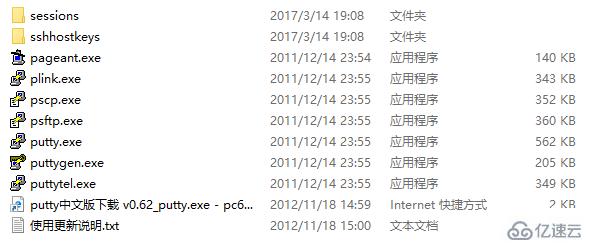
psftp.exe用于文件傳輸,我們使用putty.exe進行遠程登錄:
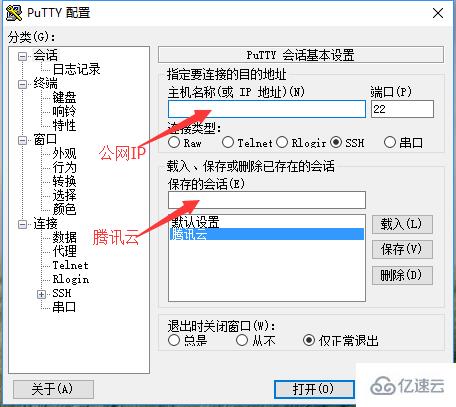
2、我們使用ssh方式連接比較安全,默認端口是22。點擊載入,這時候會提示我們輸入用戶名和密碼,正確輸入后,登錄成功!
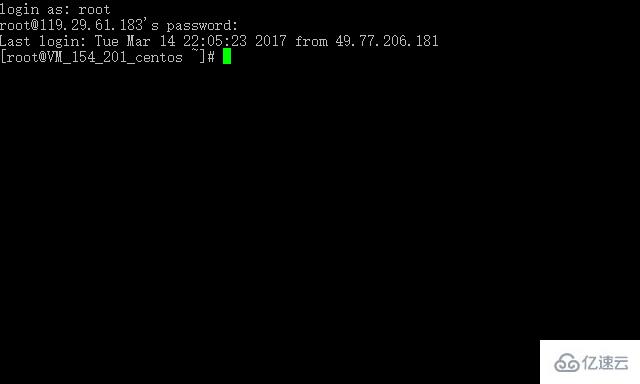
三、我們要在服務器中安裝aphache、php等軟件,就避免不了忘服務器中上傳文件,我推薦大家使用winscp這款軟件,方便直觀。
1、百度winscp,可以下載最新的版本,安裝成功后,輸入服務器的公網IP,用戶名,密碼之后就可以成功登陸了,如圖:
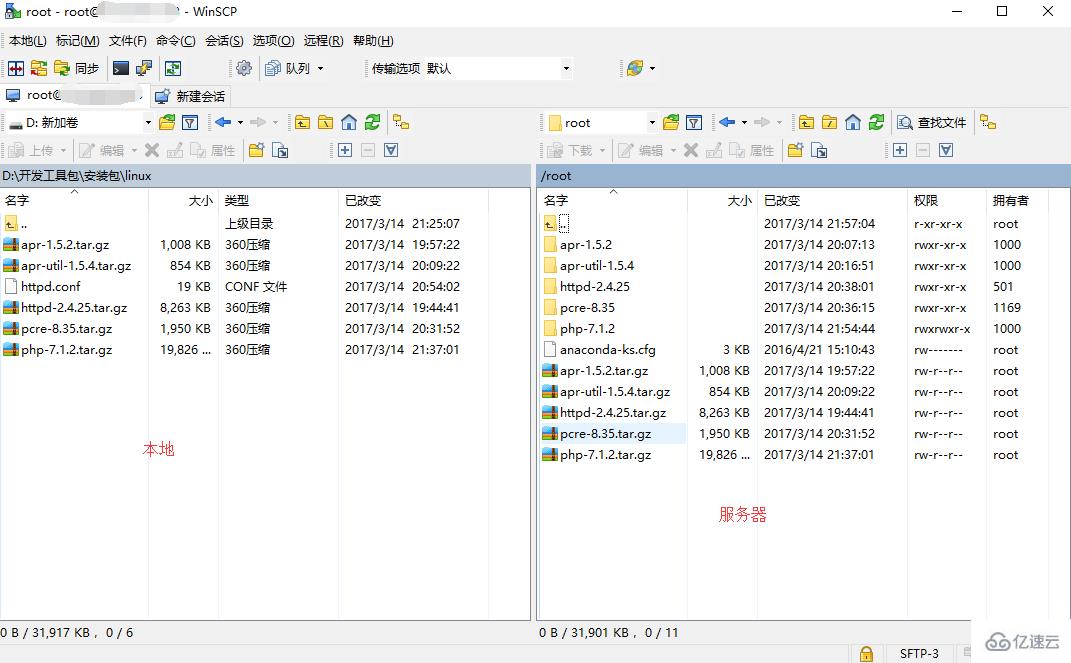
四、工具都準備好之后,我們就可以開始搭建我們的環境了,具體可以參考 http://www.cnblogs.com/lufangtao/archive/2012/12/30/2839679.html 這篇文章,寫的很透徹。
1、首先安裝apache,到官網下載linux安裝包:http://httpd.apache.org/download.cgi
安裝apache前,需要安裝APR和APR-util、prce
APR和APR-util下載地址:http://apr.apache.org/download.cgi?Preferred=http%3A%2F%2Fmirrors.hust.edu.cn%2Fapache%2F
prce下載地址:http://jaist.dl.sourceforge.NET/project/pcre/pcre/8.35/pcre-8.35.tar.gz
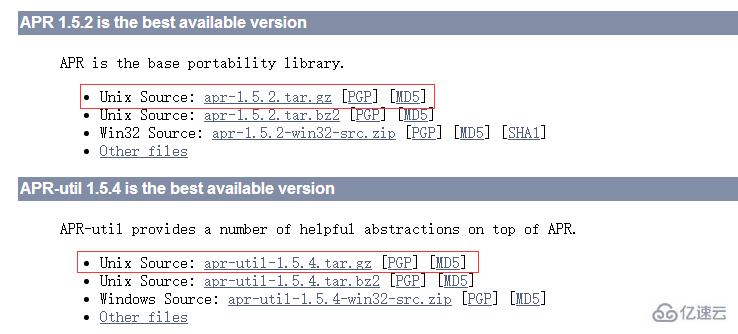
我們將這四個壓縮文件全部下載下來:

2、用winscp將這四個文件全部上傳到服務器之后,解壓:
tar -zxvf httpd-2.4.25.tar.gz
tar -zxvf apr-1.5.2.tar.gz
tar -zxvf apr-util-1.5.4.tar.gz
tar -zxvf pcre-8.35.tar.gz
3、安裝Gcc:yum install gcc
安裝C++編譯器:yum install gcc-c++
4、安裝APR:
進入解壓后APR文件夾:cd apr-1.5.2
安裝前校驗:./configure --prefix=/usr/local/apr
編譯:make
安裝:make install
5、安裝apr-util:
進入解壓后的apr-util文件夾:cd apr-util-1.5.4
安裝前校驗:./confiure --prefix=/usr/local/apr-util --with-apr=/usr/local/apr
編譯:make
安裝:make install
6、安裝pcre:
進入解壓后的pcre文件夾:cd pcre-8.35
安裝前校驗:./configure --prefix=/usr/local/pcre
編譯:make
安裝:make instal
7、安裝apache:
進入解壓后的apache文件夾:cd httpd-2.4.25
安裝前校驗:./configure --prefix=/usr/local/apache2 --enable-module=shared --with-apr=/usr/local/apr/ --with-apr-util=/usr/local/apr-util/ --with-pcre=/usr/local/pcre
編譯:make
安裝:make install
8、啟動,重啟和停止 ,先切換到安裝完成后的目錄/usr/local/apache2/bin
./apachectl -k start
./apachectl -k restart
./apachectl -k stop
9、配置文件:(滿足最基本的配置)
# # This is the main Apache HTTP server configuration file. It contains the # configuration directives that give the server its instructions. # See <URL:http://httpd.apache.org/docs/2.4/> for detailed information.# In particular, see # <URL:http://httpd.apache.org/docs/2.4/mod/directives.html># for a discussion of each configuration directive. # # Do NOT simply read the instructions in here without understanding # what they do. They're here only as hints or reminders. If you are unsure# consult the online docs. You have been warned. # # Configuration and logfile names: If the filenames you specify for many # of the server's control files begin with "/" (or "drive:/" for Win32), the # server will use that explicit path. If the filenames do *not* begin # with "/", the value of ServerRoot is prepended -- so "logs/access_log"# with ServerRoot set to "/usr/local/apache2" will be interpreted by the # server as "/usr/local/apache2/logs/access_log", whereas "/logs/access_log" # will be interpreted as '/logs/access_log'. # # ServerRoot: The top of the directory tree under which the server's# configuration, error, and log files are kept. # # Do not add a slash at the end of the directory path. If you point # ServerRoot at a non-local disk, be sure to specify a local disk on the # Mutex directive, if file-based mutexes are used. If you wish to share the # same ServerRoot for multiple httpd daemons, you will need to change at # least PidFile. # ServerRoot "/usr/local/apache2"# # Mutex: Allows you to set the mutex mechanism and mutex file directory # for inpidual mutexes, or change the global defaults # # Uncomment and change the directory if mutexes are file-based and the default# mutex file directory is not on a local disk or is not appropriate for some # other reason. # # Mutex default:logs # # Listen: Allows you to bind Apache to specific IP addresses and/or # ports, instead of the default. See also the <VirtualHost># directive. # # Change this to Listen on specific IP addresses as shown below to # prevent Apache from glomming onto all bound IP addresses. # #Listen 12.34.56.78:80Listen 80# # Dynamic Shared Object (DSO) Support # # To be able to use the functionality of a module which was built as a DSO you # have to place corresponding `LoadModule' lines at this location so the# directives contained in it are actually available _before_ they are used. # Statically compiled modules (those listed by `httpd -l') do not need# to be loaded here. # # Example: # LoadModule foo_module modules/mod_foo.so # LoadModule authn_file_module modules/mod_authn_file.so #LoadModule authn_dbm_module modules/mod_authn_dbm.so #LoadModule authn_anon_module modules/mod_authn_anon.so #LoadModule authn_dbd_module modules/mod_authn_dbd.so #LoadModule authn_socache_module modules/mod_authn_socache.so LoadModule authn_core_module modules/mod_authn_core.so LoadModule authz_host_module modules/mod_authz_host.so LoadModule authz_groupfile_module modules/mod_authz_groupfile.so LoadModule authz_user_module modules/mod_authz_user.so #LoadModule authz_dbm_module modules/mod_authz_dbm.so #LoadModule authz_owner_module modules/mod_authz_owner.so #LoadModule authz_dbd_module modules/mod_authz_dbd.so LoadModule authz_core_module modules/mod_authz_core.so LoadModule access_compat_module modules/mod_access_compat.so LoadModule auth_basic_module modules/mod_auth_basic.so #LoadModule auth_form_module modules/mod_auth_form.so #LoadModule auth_digest_module modules/mod_auth_digest.so #LoadModule allowmethods_module modules/mod_allowmethods.so #LoadModule file_cache_module modules/mod_file_cache.so #LoadModule cache_module modules/mod_cache.so #LoadModule cache_disk_module modules/mod_cache_disk.so #LoadModule cache_socache_module modules/mod_cache_socache.so #LoadModule socache_shmcb_module modules/mod_socache_shmcb.so #LoadModule socache_dbm_module modules/mod_socache_dbm.so #LoadModule socache_memcache_module modules/mod_socache_memcache.so #LoadModule watchdog_module modules/mod_watchdog.so #LoadModule macro_module modules/mod_macro.so #LoadModule dbd_module modules/mod_dbd.so #LoadModule dumpio_module modules/mod_dumpio.so #LoadModule buffer_module modules/mod_buffer.so #LoadModule ratelimit_module modules/mod_ratelimit.so LoadModule reqtimeout_module modules/mod_reqtimeout.so #LoadModule ext_filter_module modules/mod_ext_filter.so #LoadModule request_module modules/mod_request.so #LoadModule include_module modules/mod_include.so LoadModule filter_module modules/mod_filter.so #LoadModule substitute_module modules/mod_substitute.so #LoadModule sed_module modules/mod_sed.so LoadModule mime_module modules/mod_mime.so LoadModule log_config_module modules/mod_log_config.so #LoadModule log_debug_module modules/mod_log_debug.so #LoadModule logio_module modules/mod_logio.so LoadModule env_module modules/mod_env.so #LoadModule expires_module modules/mod_expires.so LoadModule headers_module modules/mod_headers.so #LoadModule unique_id_module modules/mod_unique_id.so LoadModule setenvif_module modules/mod_setenvif.so LoadModule version_module modules/mod_version.so #LoadModule remoteip_module modules/mod_remoteip.so #LoadModule proxy_module modules/mod_proxy.so #LoadModule proxy_connect_module modules/mod_proxy_connect.so #LoadModule proxy_ftp_module modules/mod_proxy_ftp.so #LoadModule proxy_http_module modules/mod_proxy_http.so #LoadModule proxy_fcgi_module modules/mod_proxy_fcgi.so #LoadModule proxy_scgi_module modules/mod_proxy_scgi.so #LoadModule proxy_fdpass_module modules/mod_proxy_fdpass.so #LoadModule proxy_wstunnel_module modules/mod_proxy_wstunnel.so #LoadModule proxy_ajp_module modules/mod_proxy_ajp.so #LoadModule proxy_balancer_module modules/mod_proxy_balancer.so #LoadModule proxy_express_module modules/mod_proxy_express.so #LoadModule proxy_hcheck_module modules/mod_proxy_hcheck.so #LoadModule session_module modules/mod_session.so #LoadModule session_cookie_module modules/mod_session_cookie.so #LoadModule session_dbd_module modules/mod_session_dbd.so #LoadModule slotmem_shm_module modules/mod_slotmem_shm.so #LoadModule lbmethod_byrequests_module modules/mod_lbmethod_byrequests.so #LoadModule lbmethod_bytraffic_module modules/mod_lbmethod_bytraffic.so #LoadModule lbmethod_bybusyness_module modules/mod_lbmethod_bybusyness.so #LoadModule lbmethod_heartbeat_module modules/mod_lbmethod_heartbeat.so LoadModule unixd_module modules/mod_unixd.so #LoadModule dav_module modules/mod_dav.so LoadModule status_module modules/mod_status.so LoadModule autoindex_module modules/mod_autoindex.so #LoadModule info_module modules/mod_info.so #LoadModule cgid_module modules/mod_cgid.so #LoadModule dav_fs_module modules/mod_dav_fs.so #LoadModule vhost_alias_module modules/mod_vhost_alias.so #LoadModule negotiation_module modules/mod_negotiation.so LoadModule dir_module modules/mod_dir.so #LoadModule actions_module modules/mod_actions.so #LoadModule speling_module modules/mod_speling.so #LoadModule userdir_module modules/mod_userdir.so LoadModule alias_module modules/mod_alias.so #LoadModule rewrite_module modules/mod_rewrite.so<IfModule unixd_module># # If you wish httpd to run as a different user or group, you must run # httpd as root initially and it will switch. # # User/Group: The name (or #number) of the user/group to run httpd as. # It is usually good practice to create a dedicated user and group for# running httpd, as with most system services. # User daemon Group daemon</IfModule># 'Main' server configuration # # The directives in this section set up the values used by the 'main'# server, which responds to any requests that aren't handled by a # <VirtualHost> definition. These values also provide defaults for# any <VirtualHost> containers you may define later in the file. # # All of these directives may appear inside <VirtualHost> containers, # in which case these default settings will be overridden for the # virtual host being defined. # # # ServerAdmin: Your address, where problems with the server should be # e-mailed. This address appears on some server-generated pages, such # as error documents. e.g. admin@your-domain.com # ServerAdmin you@example.com # # ServerName gives the name and port that the server uses to identify itself. # This can often be determined automatically, but we recommend you specify # it explicitly to prevent problems during startup. # # If your host doesn't have a registered DNS name, enter its IP address here.# ServerName localhost:80# # Deny access to the entirety of your server's filesystem. You must# explicitly permit access to web content directories in other # <Directory> blocks below. #<Directory /> AllowOverride none Require all denied</Directory># # Note that from this point forward you must specifically allow # particular features to be enabled - so if something's not working as# you might expect, make sure that you have specifically enabled it # below. # # # DocumentRoot: The directory out of which you will serve your # documents. By default, all requests are taken from this directory, but # symbolic links and aliases may be used to point to other locations. # DocumentRoot "/usr/local/apache2/htdocs" <Directory "/usr/local/apache2/htdocs"> # # Possible values for the Options directive are "None", "All", # or any combination of: # Indexes Includes FollowSymLinks SymLinksifOwnerMatch ExecCGI MultiViews # # Note that "MultiViews" must be named *explicitly* --- "Options All" # doesn't give it to you. # # The Options directive is both complicated and important. Please see # http://httpd.apache.org/docs/2.4/mod/core.html#options # for more information. # Options Indexes FollowSymLinks # # AllowOverride controls what directives may be placed in .htaccess files. # It can be "All", "None", or any combination of the keywords: # AllowOverride FileInfo AuthConfig Limit # AllowOverride None # # Controls who can get stuff from this server. # Require all granted</Directory># # DirectoryIndex: sets the file that Apache will serve if a directory # is requested. #<IfModule dir_module> DirectoryIndex index.html DirectoryIndex index.html index.php</IfModule># # The following lines prevent .htaccess and .htpasswd files from being # viewed by Web clients. #<Files ".ht*"> Require all denied</Files># # ErrorLog: The location of the error log file. # If you do not specify an ErrorLog directive within a <VirtualHost># container, error messages relating to that virtual host will be # logged here. If you *do* define an error logfile for a <VirtualHost># container, that host's errors will be logged there and not here.# ErrorLog "logs/error_log"# # LogLevel: Control the number of messages logged to the error_log. # Possible values include: debug, info, notice, warn, error, crit, # alert, emerg. # LogLevel warn<IfModule log_config_module> # # The following directives define some format nicknames for use with # a CustomLog directive (see below). # LogFormat "%h %l %u %t \"%r\" %>s %b \"%{Referer}i\" \"%{User-Agent}i\"" combined LogFormat "%h %l %u %t \"%r\" %>s %b" common <IfModule logio_module> # You need to enable mod_logio.c to use %I and %O LogFormat "%h %l %u %t \"%r\" %>s %b \"%{Referer}i\" \"%{User-Agent}i\" %I %O" combinedio </IfModule> # # The location and format of the access logfile (Common Logfile Format). # If you do not define any access logfiles within a <VirtualHost> # container, they will be logged here. Contrariwise, if you *do* # define per-<VirtualHost> access logfiles, transactions will be # logged therein and *not* in this file. # CustomLog "logs/access_log" common # # If you prefer a logfile with access, agent, and referer information # (Combined Logfile Format) you can use the following directive. # #CustomLog "logs/access_log" combined</IfModule> <IfModule alias_module> # # Redirect: Allows you to tell clients about documents that used to # exist in your server's namespace, but do not anymore. The client # will make a new request for the document at its new location. # Example: # Redirect permanent /foo http://www.example.com/bar # # Alias: Maps web paths into filesystem paths and is used to # access content that does not live under the DocumentRoot. # Example: # Alias /webpath /full/filesystem/path # # If you include a trailing / on /webpath then the server will # require it to be present in the URL. You will also likely # need to provide a <Directory> section to allow access to # the filesystem path. # # ScriptAlias: This controls which directories contain server scripts. # ScriptAliases are essentially the same as Aliases, except that # documents in the target directory are treated as applications and # run by the server when requested rather than as documents sent to the # client. The same rules about trailing "/" apply to ScriptAlias # directives as to Alias. # ScriptAlias /cgi-bin/ "/usr/local/apache2/cgi-bin/" </IfModule> <IfModule cgid_module> # # ScriptSock: On threaded servers, designate the path to the UNIX # socket used to communicate with the CGI daemon of mod_cgid. # #Scriptsock cgisock</IfModule># # "/usr/local/apache2/cgi-bin" should be changed to whatever your ScriptAliased # CGI directory exists, if you have that configured. #<Directory "/usr/local/apache2/cgi-bin"> AllowOverride None Options None Require all granted</Directory> <IfModule headers_module> # # Avoid passing HTTP_PROXY environment to CGI's on this or any proxied # backend servers which have lingering "httpoxy" defects. # 'Proxy' request header is undefined by the IETF, not listed by IANA # RequestHeader unset Proxy early</IfModule> <IfModule mime_module> # # TypesConfig points to the file containing the list of mappings from # filename extension to MIME-type. # TypesConfig conf/mime.types # # AddType allows you to add to or override the MIME configuration # file specified in TypesConfig for specific file types. # #AddType application/x-gzip .tgz # # AddEncoding allows you to have certain browsers uncompress # information on the fly. Note: Not all browsers support this. # #AddEncoding x-compress .Z #AddEncoding x-gzip .gz .tgz # # If the AddEncoding directives above are commented-out, then you # probably should define those extensions to indicate media types: # AddType application/x-compress .Z AddType application/x-gzip .gz .tgz AddType application/x-httpd-php .php AddType application/x-httpd-php-source .php5 # # AddHandler allows you to map certain file extensions to "handlers": # actions unrelated to filetype. These can be either built into the server # or added with the Action directive (see below) # # To use CGI scripts outside of ScriptAliased directories: # (You will also need to add "ExecCGI" to the "Options" directive.) # #AddHandler cgi-script .cgi # For type maps (negotiated resources): #AddHandler type-map var # # Filters allow you to process content before it is sent to the client. # # To parse .shtml files for server-side includes (SSI): # (You will also need to add "Includes" to the "Options" directive.) # #AddType text/html .shtml #AddOutputFilter INCLUDES .shtml</IfModule># # The mod_mime_magic module allows the server to use various hints from the # contents of the file itself to determine its type. The MIMEMagicFile # directive tells the module where the hint definitions are located. # #MIMEMagicFile conf/magic # # Customizable error responses come in three flavors: # 1) plain text 2) local redirects 3) external redirects # # Some examples: #ErrorDocument 500 "The server made a boo boo."#ErrorDocument 404 /missing.html #ErrorDocument 404 "/cgi-bin/missing_handler.pl"#ErrorDocument 402 http://www.example.com/subscription_info.html# # # MaxRanges: Maximum number of Ranges in a request before # returning the entire resource, or one of the special # values 'default', 'none' or 'unlimited'. # Default setting is to accept 200 Ranges. #MaxRanges unlimited # # EnableMMAP and EnableSendfile: On systems that support it, # memory-mapping or the sendfile syscall may be used to deliver # files. This usually improves server performance, but must # be turned off when serving from networked-mounted # filesystems or if support for these functions is otherwise # broken on your system. # Defaults: EnableMMAP On, EnableSendfile Off # #EnableMMAP off #EnableSendfile on # Supplemental configuration # # The configuration files in the conf/extra/ directory can be # included to add extra features or to modify the default configuration of # the server, or you may simply copy their contents here and change as # necessary. # Server-pool management (MPM specific) #Include conf/extra/httpd-mpm.conf # Multi-language error messages #Include conf/extra/httpd-multilang-errordoc.conf # Fancy directory listings #Include conf/extra/httpd-autoindex.conf # Language settings #Include conf/extra/httpd-languages.conf # User home directories #Include conf/extra/httpd-userdir.conf # Real-time info on requests and configuration #Include conf/extra/httpd-info.conf # Virtual hosts #Include conf/extra/httpd-vhosts.conf # Local access to the Apache HTTP Server Manual #Include conf/extra/httpd-manual.conf # Distributed authoring and versioning (WebDAV) #Include conf/extra/httpd-dav.conf # Various default settings #Include conf/extra/httpd-default.conf # Configure mod_proxy_html to understand HTML4/XHTML1<IfModule proxy_html_module>Include conf/extra/proxy-html.conf</IfModule># Secure (SSL/TLS) connections #Include conf/extra/httpd-ssl.conf # # Note: The following must must be present to support # starting without SSL on platforms with no /dev/random equivalent # but a statically compiled-in mod_ssl. #<IfModule ssl_module>SSLRandomSeed startup builtin SSLRandomSeed connect builtin</IfModule>
10 、測試:
在瀏覽器里輸入http://公網Ip,顯示如下,配置成功。
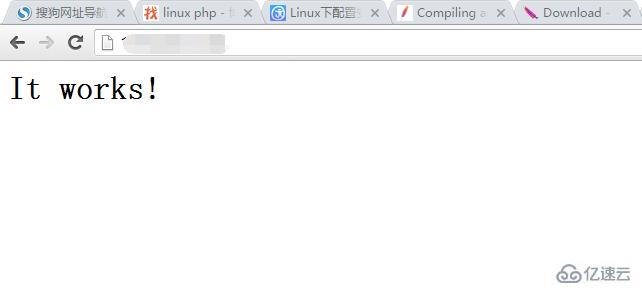
五、安裝php
1、官網上下載php壓縮包,并上傳到服務器解壓:http://www.php.net/downloads.php
2、建立目標文件夾mkdir /usr/local/php,等下php安裝到該目錄下。
3、安裝前校驗: ./configure --prefix=/usr/local/php --with-apxs2=/usr/local/apache/bin/apxs
可能會提示出現錯誤:configure: error: xml2-config not found. Please check your libxml2 installation。運行yum install libxml2,然后再運行yum install libxml2-devel安裝完畢后,重新運行上面的./configure命令。
4、編譯:make
5、編譯測試:make test
6、編譯安裝:make install
7、在apache的htdocs下建立一個php文件test.php,里面的內容如下:
<?php phpinfo(); ?>
重啟apache服務器,在瀏覽器中輸入:http://公網IP/test.php,結果如下:
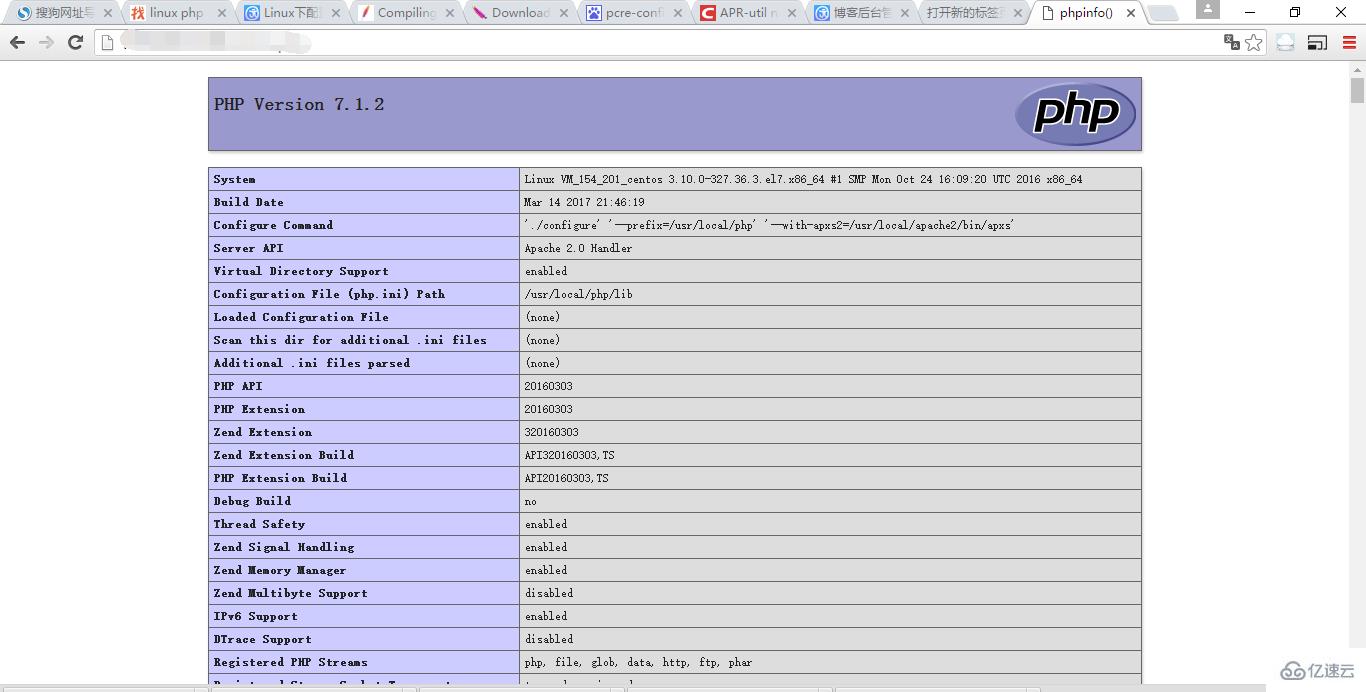
php配置成功!
感謝各位的閱讀,以上就是“騰訊云里怎么安裝php”的內容了,經過本文的學習后,相信大家對騰訊云里怎么安裝php這一問題有了更深刻的體會,具體使用情況還需要大家實踐驗證。這里是億速云,小編將為大家推送更多相關知識點的文章,歡迎關注!
免責聲明:本站發布的內容(圖片、視頻和文字)以原創、轉載和分享為主,文章觀點不代表本網站立場,如果涉及侵權請聯系站長郵箱:is@yisu.com進行舉報,并提供相關證據,一經查實,將立刻刪除涉嫌侵權內容。